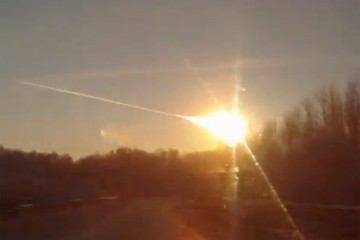An asteroid the size of a 737 airliner is presently hurtling toward Earth, set to pass within a relative stone's throw of our planet on Friday.
The asteroid, called 2012 DA14, poses no threat, NASA says; it's not expected to come within 17,000 miles of Earth. But that qualifies as a near miss in space terms, the closest pass of an object that size ever recorded. The asteroid was expected to pass by Earth over Asia at about 2:25 p.m. EST. Live coverage is available online.
The close encounter has scientists thinking—what if a similar object was on a collision course with Earth? What could we do to stop it, to avert potential devastation?
"One of these days, almost certainly an asteroid is going to be predicted to be able to hit Earth," says Andy Cheng, chief scientist of the Space Department at Johns Hopkins' Applied Physics Laboratory. "What do you do? Well, let's try to move it into a different orbit. One of the ways you could think of doing that is to crash a spaceship into it."
If you think that sounds like the plot line for a Michael Bay summer blockbuster, think again.
Cheng is working on a project called AIDA—Asteroid Impact and Deflection Assessment—a joint mission with NASA/APL and the European Space Agency. He spoke with Johns Hopkins Magazine about the project for the Spring 2013 issue, which will be released at the beginning of March. Cheng also served as the lead scientist for NASA's Near Earth Asteroid Rendezvous (NEAR), which in 2000-2001 became the first mission to orbit and land on an asteroid.
Cheng said Friday's meteor explosion over central Russia was likely not related to today's expected flyby.
According to NASA, nearly 10,000 objects have been classified as Near Earth Objects, or NEOs. More than 1,300 of those NEOs—comets and asteroids—have been described as potentially hazardous to Earth. NASA monitors them closely and has not identified any imminent threats, but scientists estimate that an asteroid the size of DA14 or larger impacts Earth about once every 1,200 years.
A team at the Hopkins Extreme Materials Institute has developed a computer model for asteroids to simulate a planetary impact event.
"Major impact events have the potential to create global catastrophes," said K.T. Ramesh, a professor at the Whiting School of Engineering and founding director of the institute. "It is highly likely that the next destructive impact event on Earth will be a low-altitude airburst from an asteroid similar to 2012 DA14."
Richard Conn Henry, an astrophysicist in the Krieger School of Arts and Sciences, isn't worried about Friday's flyby. Instead, he's grateful for the headline-generating near miss.
"It is helpful, a wake-up call that we should be cataloging all asteroids in case there is one out there with our name on it," he said. "If we caught it enough years in advance, we could do something about it."
Posted in Science+Technology
Tagged applied physics laboratory, k.t. ramesh, nasa, space, andy cheng, richard henry









